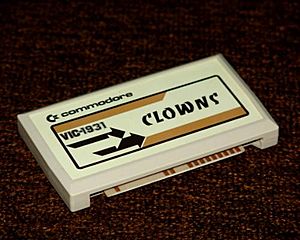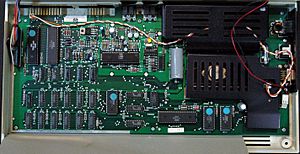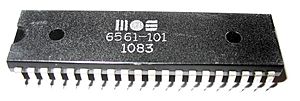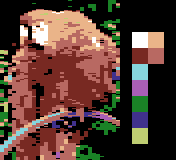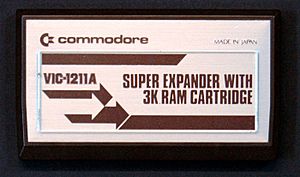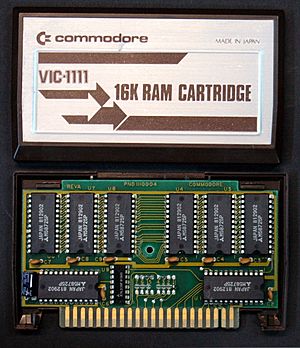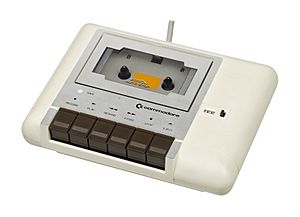VIC-20 facts for kids
 |
|
 |
|
| Manufacturer | Commodore Business Machines |
|---|---|
| Type | Home computer |
| Release date | Japan: 1980, Worldwide: 1981 |
| Retail availability | 5 years |
| Introductory price | US$299.95 (equivalent to $970 in 2022) |
| Discontinued | January 1985 |
| Units sold | 3 million units sold worldwide. |
| Operating system | Commodore KERNAL Commodore BASIC 2.0 |
| CPU | MOS Technology 6502 @ 1.108 MHz (PAL) @ 1.02 MHz (NTSC) |
| Memory | 20 KB ROM + 5 KB RAM (expandable to 32 KB) 3.5 KB for BASIC (expandable to 27.5 KB) |
| Storage | Compact Cassette, floppy disk |
| Display | Commodore 1701; 176 x 184, 16 color composite palette |
| Graphics | MOS Technology VIC |
| Sound | MOS Technology VIC; 3 square and 1 noise channels |
| Input | Tape, floppy disk, cartridge |
| Predecessor | Commodore PET |
| Successor | Commodore 64, Commodore 16, MAX Machine |
The VIC-20 was a groundbreaking 8-bit home computer made by Commodore Business Machines. It was first announced in 1980. This computer was special because it was the first computer ever to sell over one million units! People called it "the computer of the future." It was designed to be easy for everyone to use, not just computer experts.
Contents
The Story of the VIC-20
In 1979, the Apple II computer became very popular. Jack Tramiel, who led Commodore, wanted to create a computer that could compete. He wanted a product ready for the January 1980 Consumer Electronics Show (CES).
At this time, computer parts were becoming cheaper. Tramiel saw a chance to sell low-cost computers in regular stores. These computers would be for everyday people, not just tech experts. Other companies like Radio Shack were already selling affordable computers. Their TRS-80 Model I and Color Computer were popular with families and schools.
How the VIC-20 Was Made
A new engineer named Robert Yannes at MOS Technology (part of Commodore) secretly built a computer prototype at home. He called it the MicroPET. When Jack Tramiel saw it, he loved it! He immediately ordered it to be made for everyone to buy.
However, Yannes's prototype needed more work to become a real computer. Robert Russell at Commodore helped finish the design. He added the operating system and BASIC language from another Commodore computer, the PET. He also included a special character set and a port for joysticks. Another team member, Glen Stark, designed a cheaper way to connect to other devices like disk drives.
The VIC-20 development team had five people, led by Michael Tomczyk. Tomczyk pushed for important features like full-size keys and special function keys. He also wanted a built-in connection for modems. He even helped create the VICModem, which was the first modem to sell over a million units!
Commodore had many extra memory chips. Tramiel decided to use these in the new computer. This helped keep the cost down. The first VIC-20 models had 5 KB of RAM, which was small even then. But it used special memory (SRAM) that used less power.
In April 1980, Jack Tramiel said he wanted a low-cost color computer. He believed Commodore needed to make "computers for the masses." Some engineers disagreed and left. But a team in Japan helped finish the design. The VIC-20 was first sold in Japan as the VIC-1001.
Michael Tomczyk wrote a detailed plan for the new computer. He suggested a price of $299.95. He also worked with teams in the UK and Japan to create colorful packaging and user manuals. He even hired a game designer, Scott Adams, to make popular text adventure games for the VIC-20. These games came on special cartridges to save memory.
Changes Over Time
The VIC-20 changed a bit during its production. Early models had a keyboard similar to the PET computer. Later models, made after 1981, had a slightly different keyboard. In 1983, the "rainbow logo" VIC-20 came out. It had a newer keyboard and a different internal design.
The End of the VIC-20
The VIC-20 was a huge success, selling over 2.5 million units. But in 1982, Commodore released the Commodore 64. This new computer was much more advanced, with more memory and better sound and graphics. Sales of the Commodore 64 grew quickly. By 1983, the VIC-20 was selling for under $90. Commodore stopped making the VIC-20 in January 1985.
How the VIC-20 Was Designed
The VIC-20 was made to be cheaper than the older PET computer. It had 5 KB of RAM and used the same MOS 6502 CPU chip as the PET. The VIC-20's special video chip, called the MOS Technology VIC, was designed for simple display screens and game consoles.
The VIC-20 used an older version of the BASIC programming language. It also had a special video output that gave a clearer picture if you used a dedicated monitor. Other computers at the time often only had a basic TV connection.
The "20" in the name didn't mean anything specific. One of the designers said they picked "20" because it sounded friendly. The computer's slogan was "The Friendly Computer."
Graphics Capabilities
The VIC chip (6560/6561) had simple but flexible graphics. The screen usually showed 176x184 pixels. It had a border around the edges. The screen normally showed 22 columns and 23 rows of characters. Each character was 8x8 pixels. You could choose from two different sets of 256 characters.
The VIC chip didn't have a true "bitmap" mode, which lets you control every single dot on the screen. But programmers could create their own characters. This allowed them to make detailed graphics by changing how characters looked. For example, the game Omega Race used this trick to create a larger game area.
The VIC chip could also work with a light pen, but these were not very common. The VIC-20 sent out video signals that created its picture. Commodore didn't put the TV connection inside the computer. Instead, you used an external device to connect it to a TV.
Sound Features
The VIC chip had sound capabilities too. It had three sound generators that made "square wave" sounds. It also had a "white noise" generator. You could control the overall volume. Each sound generator could play notes across about three octaves, giving a total range of five octaves.
Memory and Expansion
The VIC-20 came with 5 KB of RAM. However, some of this memory was used for the screen display and the computer's basic operating system. This meant only about 3.5 KB was available for your programs and data.
You could add more RAM to the VIC-20 using special cartridges. Commodore sold cartridges with 3 KB, 8 KB, and 16 KB of RAM. These cartridges changed how the computer used its memory. Some programs only worked if you had a specific amount of extra memory. With expansion cartridges, you could get up to 27.5 KB of RAM for your BASIC programs.
Connecting Other Devices
The VIC-20 had several ports to connect other devices. It had a port for game cartridges and a port for the Datasette tape drive. This tape drive was used to save and load programs.
Later, a disk drive called the VIC-1540 was released in 1981. The VIC-20 also had a special port for joysticks, similar to those used with the Atari 2600. There was a serial port to connect disk drives and printers in a "daisy chain" (one after another). It also had a "user port" for connecting modems or other electronic projects.
The VIC-20's cartridge port was used for games and other software. It also allowed you to add more memory. You could even buy boxes that let you plug in more than one cartridge at a time.
In 1981, the VICModem was created. It was a modem that plugged directly into the computer. At $99, it was the first modem to cost under $100. It was also the first modem to sell over 1 million units! The VICModem came with free online services like The Source and CompuServe.
What You Could Do with a VIC-20
The VIC-20's BASIC programming language was similar to the PET's. Before the computer came out, Commodore promised it would be easy for programmers to create their own software. Because it had limited memory and screen resolution, the VIC-20 was mostly used for educational programs and games. However, people also used it for things like home finance, spreadsheets, and communication programs.
There was a lot of free software available for the VIC-20. You could find it on online services, bulletin board systems (BBSs), or through mail order. Many computer magazines also published programs you could type into your VIC-20.
About 300 commercial games and programs were sold on cartridges. Over 500 more were available on tape. A few programs were even released on disk.
Because the VIC-20 was so affordable, some businesses used it. For example, a utility company in Florida used multiple VIC-20s (and later Commodore 64s) to monitor their power generators. They could buy many VIC-20s for the price of just one IBM PC!
Marketing and Sales
The PET computer was sold through special dealers. But the VIC-20 was sold in regular stores, like discount stores and toy stores. This allowed it to compete directly with video game consoles. It was the first computer ever sold in K-Mart stores.
Commodore hired famous actor William Shatner (Captain Kirk from Star Trek) to be their spokesperson. He would ask, "Why buy just a video game?" and call the VIC-20 "The Wonder Computer of the 1980s."
In Germany, the VIC-20 was called the VC-20. This was short for VolksComputer, which means "people's computer." This was similar to the name of the famous car, Volkswagen.
Images for kids
See also
 In Spanish: Commodore VIC-20 para niños
In Spanish: Commodore VIC-20 para niños
- VICE emulator
- List of VIC-20 games



